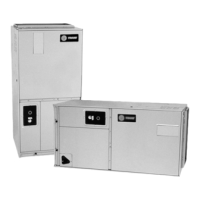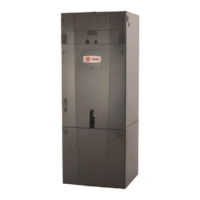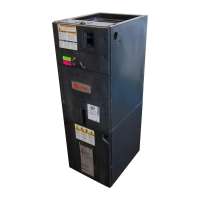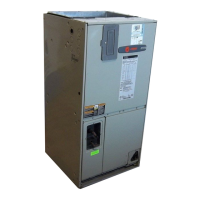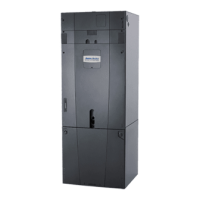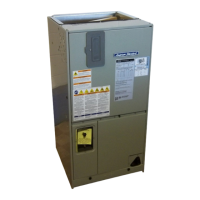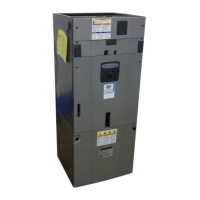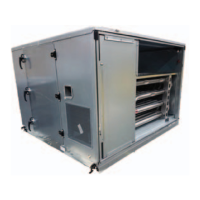Installation
RT-SVX35H-EN 27
Roof Curb and Ductwork
The roof curbs for W_HE casings 2 through 9 units consists
of a "full perimeter" enclosure to support the unit.
Before installing any roof curb:
1. Verify that it is the correct curb for the unit,
2. Verify that it includes the necessary gaskets and
hardware,
3. Verify that the purposed installation location provides
the required clearance for proper operation.
4. Insu
re that the curb is level and square. The top surface
of the curb must be true to assure an adequate curb-to-
unit seal.
Step-by-step curb assembly and installation instructions
ship with each Trane accessory roof curb kit. Refer to the
applicable sections in the current edition of RT-SVN14*-EN
for W_HE casings 2 through 9. Follow the instructions
carefully to assure proper fit-up when the unit is s
et into
place.
Note: To assure proper condensate flow during
operation, the unit (and curb) must be as level as
possible. The maximum slope allowable for
rooftop unit applications is 4" end-to-end and 2"
side-to-side excluding WSHE. Units with steam
coils (WSHE's) must be set level!
If the unit is elevated, a field constructed catwalk around
the unit is strongly recommended to provide easy access
for
unit maintenance and service.
Re
commendations for installing the Supply and Return Air
ductwork joining the roof curb are included in the curb
instruction booklet. Curb ductwork must be fabricated and
installed by the installing contractor before the unit is set
into place.
Note: For sound considerations, cut only the holes in the
roof deck for the ductwork penetrations. Do not cut
out the entire
roof deck within the curb perimeter.
T
rane's Engineering Bulletin RT-PRB022-EN provides
additional information concerning duct design and sound
reduction.
Pitch Pocket Location
The location of the main supply power entry for W_HE
Casings 2 through 6 units is located in the bottom right-
hand area of the control panel. Figure 8, p. 23 illustrates
the electrical entrance location for the control panel. I
f the
p
ower supply conduit penetrates the building’s roof
Chilled Water Coil
(b)
- Aluminum
(Shipping/Operating)
462/564 591/751 (1) 344/418 (2) 462/564 (1) 451/551 (5-Row) 722
(1)424/517 (1)554/680 (2) 957/1184
Chilled Water Coil(b) - Copper
(Shipping/Operating)
955/1057 1307/1468 (1) 702/777 (2) 955/1057 1) 955/1057
(1) 872/965 (1) 1173/1299 (2) 2097/2325
Hot Water Coil
217 217 269 269 324
Steam Coil
176 176 256 256 312 552
Supply Motor Std.
122 231 304 345 455 448
Supply Motor Hi-Eff.
140 195 280 360 480 (2) 455
Exhaust Motor - Std.
60 104 122 191 231 (2) 480
Exhaust Motor - Hi-Eff.
64 113 140 189 195 455
Supply Fan Assy.
234 344 530 530 748 480
Variable Frequency Drive
21 27 32 38 49 (2) 735
Exhaust Fan Assy
234 234 344 324 530 (2) 100
Gas Heat Low
(Includes Control Box)
270 306 306 395 395 748
Gas Heat High
(Includes Control Box)
395 395 630 630 630 800
Electric Heat
(c)
(Includes Control Box)
130 130 155 155 155
Main Control Box(c)
150 150 200 220 250 155
Filter Assembly(c)
60 70 70 85 100 350
FA/RA Damper(c)
45 60 75 90 95 125
Exhaust Damper(c)
(2) 30 (2) 35 (2) 50 (2) 55 (2) 50 150
Eliminator Panel
(1) 50 (1) 58 (1) 68 (2)75 (2) 60 (2) 55
(a) Cabinet weights are estimated based on:
4.4 Lbs./Ft2of surface for Casing Sizes 2-5.
4.6 Lbs./Ft2 of surface area for Casing Size 6.
(b) Chilled Water coil weights are for maximum size coil.
(c) Estimated Weights
Table 5. Component weights (Lbs.) — casings 2-9
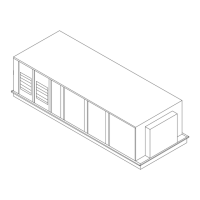
